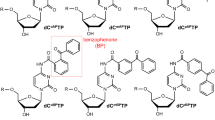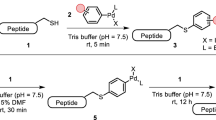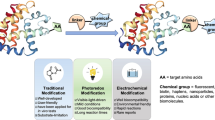Abstract
Bioconjugation and functionalization of polymer surfaces are two major tasks in materials chemistry which are accomplished using a variety of coupling agents. Immobilization of biomolecules onto polymer surfaces and the construction of bioconjugates are essential requirements of many biochemical assays and chemical syntheses. Different linkers with a variety of functional groups are used for these purposes. Among them, the benzophenones, aryldiazirines, and arylazides represent the most commonly used photolinker to produce the desired chemical linkage upon their photo-irradiation. In this review, we describe the versatile applications of 4-fluoro-3-nitrophenyl azide, one of the oldest photolinkers used for photoaffinity labeling in the late 1960s. Surprisingly, this photolinker, historically known as 1-fluoro-2-nitro-4-azidobenzene (FNAB), has remained unexplored for a long time because of apprehension that FNAB forms ring-expanded dehydroazepine as a major product and hence cannot activate an inert polymer. The first evidence of photochemical activation of an inert surface by FNAB through nitrene insertion reaction was reported in 2001, and the FNAB-activated surface was found to conjugate a biomolecule without any catalyst, reagent, or modification. FNAB has distinct advantages over perfluorophenyl azide derivatives, which are contemporary nitrene-generating photolinkers, because of its simple, single-step preparation and ease of thermochemical and photochemical reactions with versatile polymers and biomolecules. Covering these aspects, the present review highlights the flexible chemistry of FNAB and its applications in the field of surface engineering, immobilization of biomolecules such as antibodies, enzymes, cells, carbohydrates, oligonucleotides, and DNA aptamers, and rapid diagnostics.

An overview of the FNAB-engineered activated polymer surfaces for covalent ligation of versatile biomolecules










Similar content being viewed by others
References
Hermanson GT. Introduction to bioconjugation. In: Bioconjugate techniques. 3rd ed. Boston: Academic. 2013; 1–125. doi:10.1016/B978-0-12-382239-0.00001-7.
Kalia J, Raines RT. Advances in bioconjugation. Curr Org Chem. 2010;14(2):138–47.
Wong M, Jameson SS. Overview of protein conjugation. In: Chemistry of protein and nucleic acid cross-linking and conjugation. 2nd ed. Boca Raton: CRC. 2011; 18. doi:10.1201/b11175-2.
Thavarajah R, Mudimbaimannar VK, Elizabeth J, Rao UK, Ranganathan K. Chemical and physical basics of routine formaldehyde fixation. J Oral Maxillofac Pathol. 2012;16(3):400–5. doi:10.4103/0973-029X.102496.
Sewell BT, Bouloukos C, von Holt C. Formaldehyde and glutaraldehyde in the fixation of chromatin for electron microscopy. J Microsc. 1984;136(Pt 1):103–12.
Kiernan J. Formaldehyde, formalin, paraformaldehyde and glutaraldehyde: what they are and what they do. Microsc Today. 2000;1:8–12.
Khorana HG. The chemistry of carbodiimides. Chem Rev. 1953;53(2):145–66. doi:10.1021/cr60165a001.
Kurzer F, Douraghi-Zadeh K. Advances in the chemistry of carbodiimides. Chem Rev. 1967;67(2):107–52. doi:10.1021/cr60246a001.
Williams A, Ibrahim IT. Carbodiimide chemistry: recent advances. Chem Rev. 1981;81(6):589–636. doi:10.1021/cr00046a004.
Hunter MJ, Ludwig ML. The reaction of imidoesters with proteins and related small molecules. J Am Chem Soc. 1962;84(18):3491–504. doi:10.1021/ja00877a016.
Heterobifunctional Cross-Linkers. In: Chemistry of Protein and Nucleic Acid Cross-Linking and Conjugation, Second Edition. CRC Press. 2011; 191–238. doi:10.1201/b11175-7.
Monofunctional and Zero -Length Cross -Linking Reagents. In: Chemistry of Protein and Nucleic Acid Cross-Linking and Conjugation, Second Edition. CRC Press. 2011; 265–296. doi:10.1201/b11175-9.
Hermanson GT. Chapter 5 - Homobifunctional Crosslinkers. In: Bioconjugate Techniques (Third edition). Academic Press, Boston. 2013; 275–298. doi:10.1016/B978-0-12-382239-0.00005-4.
Patil US, Qu H, Caruntu D, O’Connor CJ, Sharma A, Cai Y, Tarr MA. Labeling Primary Amine Groups in Peptides and Proteins with N-Hydroxysuccinimidyl Ester Modified Fe(3)O(4)@SiO(2) Nanoparticles Containing Cleavable Disulfide-bond Linkers. Bioconjugate Chem. 2013; 24 (9). doi:10.1021/bc400165r.
Klykov O, Weller MG. Quantification of N-hydroxysuccinimide and N-hydroxysulfosuccinimide by hydrophilic interaction chromatography (HILIC). Anal Methods. 2015;7(15):6443–8. doi:10.1039/C5AY00042D.
Fleet G, Porter R, Knowles J. Affinity labelling of antibodies with aryl nitrene as reactive group. Nature. 1969;224(5218):511–2.
Bayley H, Knowles JR. [8] Photoaffinity labeling. In: Methods in Enzymology, vol Volume 46. Academic Press. 1977; 69–114. doi:10.1016/S0076-6879(77)46012-9.
Brunner J. New photolabeling and crosslinking methods. Annu Rev Biochem. 1993;62:483–514. doi:10.1146/annurev.bi.62.070193.002411.
Bayley H. Photogenerated reagents in biochemistry and molecular biology. In Laboratory Techniques in Biochemistry and Molecular Biology, vol 12. Elsevier, New York, Work TS, Burdon RH. Eds. 1983.
Liu L, Engelhard MH, Yan M. Surface and interface control on photochemically initiated immobilization. J Am Chem Soc. 2006;128(43):14067–72. doi:10.1021/ja062802l.
Brase S, Gil C, Knepper K, Zimmermann V. Organic azides: an exploding diversity of a unique class of compounds. Angew Chem (Int ed Engl). 2005;44(33):5188–240. doi:10.1002/anie.200400657.
Meijer EW, Nijhuis S, Van Vroonhoven FCBM. Poly-1,2-azepines by the photopolymerization of phenyl azides. Precursors for conducting polymer films. J Am Chem Soc. 1988;110(21):7209–10. doi:10.1021/ja00229a043.
Gomez N, Schmidt CE. Nerve growth factor-immobilized polypyrrole: bioactive electrically conducting polymer for enhanced neurite extension. J Biomed Mater Res Part A. 2007;81(1):135–49. doi:10.1002/jbm.a.31047.
Jagur-Grodzinski J. Biomedical applications of electrically conductive polymeric systems. e-Polymers. 2012;12. doi:10.1515/epoly.2012.12.1.722
Liu LH, Yan M. Perfluorophenyl azides: new applications in surface functionalization and nanomaterial synthesis. Acc Chem Res. 2010;43(11):1434–43. doi:10.1021/ar100066t.
Liu LH, Lerner MM, Yan M. Derivitization of pristine graphene with well-defined chemical functionalities. Nano Lett. 2010;10(9):3754–6. doi:10.1021/nl1024744.
Liu L-H, Yan M. Functionalization of pristine graphene with perfluorophenyl azides. J Mater Chem. 2011;21(10):3273–6. doi:10.1039/C0JM02765K.
Al-Bataineh SA, Luginbuehl R, Textor M, Yan M. Covalent immobilization of antibacterial furanones via photochemical activation of perfluorophenylazide. Langmuir. 2009;25(13):7432–7. doi:10.1021/la900334w.
Yakai FENGHZ, Li ZHANG, Jintang GUO. Surface modification of biomaterials by photochemical immobilization and photograft polymerization to improve hemocompatibility. Front Chem Sci Eng. 2010;4(3):372–81. doi:10.1007/s11705-010-0005-z.
Harmer MA. Photomodification of surfaces using heterocyclic azides. Langmuir. 1991;7(10):2010–2. doi:10.1021/la00058a007.
Blencowe A, Hayes W. Development and application of diazirines in biological and synthetic macromolecular systems. Soft Matter. 2005;1(3):178–205. doi:10.1039/B501989C.
Dubinsky L, Krom BP, Meijler MM. Diazirine based photoaffinity labeling. Bioorg Med Chem. 2012;20(2):554–70. doi:10.1016/j.bmc.2011.06.066.
Dorman G, Prestwich GD. Benzophenone photophores in biochemistry. Biochemistry. 1994;33(19):5661–73.
Hino N, Okazaki Y, Kobayashi T, Hayashi A, Sakamoto K, Yokoyama S. Protein photo-cross-linking in mammalian cells by site-specific incorporation of a photoreactive amino acid. Nat Methods. 2005;2(3):201–6. doi:10.1038/nmeth739.
Borden WT, Gritsan NP, Hadad CM, Karney WL, Kemnitz CR, Platz MS. The interplay of theory and experiment in the study of phenylnitrene. Acc Chem Res. 2000;33(11):765–71.
Gritsan NP, Platz MS. Kinetics, spectroscopy, and computational chemistry of arylnitrenes. Chem Rev. 2006;106(9):3844–67. doi:10.1021/cr040055+.
Gritsan N, Platz M. Photochemistry of azides: the azide/nitrene interface. Chichester: Wiley; 2010.
Platz MS. Comparison of phenylcarbene and phenylnitrene. Acc Chem Res. 1995;28(12):487–92.
Dunkin IR, Thomson PC. Pentafluorophenyl nitrene: a matrix isolated aryl nitrene thet does not undergo ring expansion. J Chem Soc Chem Commun. 1982;20:1192–3.
Schrock AK, Schuster GB. Photochemistry of phenyl azide: chemical properties of the transient intermediates. J Am Chem Soc. 1984;106(18):5228–34.
Leyva E, Platz MS, Persy G, Wirz J. Photochemistry of phenyl azide: the role of singlet and triplet phenylnitrene as transient intermediates. J Am Chem Soc. 1986;108(13):3783–90.
Wentrup C, Winter HW. Isolation of diazacycloheptatetraenes from thermal nitrene-nitrene rearrangements. J Am Chem Soc. 1980;102(19):6159–61.
Schnapp KA, Poe R, Leyva E, Soundararajan N, Platz MS. Exploratory photochemistry of fluorinated aryl azides. Implications for the design of photoaffinity labeling reagents. Bioconjug Chem. 1993;4(2):172–7.
Tate JJ, Persinger J, Bartholomew B. Survey of four different photoreactive moieties for DNA photoaffinity labeling of yeast RNA polymerase III transcription complexes. Nucleic Acids Res. 1998;26(6):1421–6.
Smith BA, Cramer CJ. How Do different fluorine substitution patterns affect the electronic state energies of phenylnitrene? J Am Chem Soc. 1996;118(23):5490–1.
Leyva E, Sagredo R. Photochemistry of fluorophenyl azides in diethylamine. Nitrene reaction versus ring expansion. Tetrahedron. 1998;54(26):7367–74.
Leyva E, Sagredo R, Moctezuma E. Photochemistry of fluorophenyl azides in aniline: asymmetric fluoroazobenzenes by N• H singlet nitrene insertion. J Fluor Chem. 2004;125(5):741–7.
Albini A, Bettinetti G, Minoli G. The effect of the p-nitro group on the chemistry of phenylnitrene. A study via intramolecular trapping. J Chem Soc Perkin Trans. 1999;2(12):2803–7.
Liang TY, Schuster GB. Photochemistry of 3-and 4-nitrophenyl azide: detection and characterization of reactive intermediates. J Am Chem Soc. 1987;109(25):7803–10.
Nina PG, Elena AP. The mechanism of photolysis of aromatic azides. Russ Chem Rev. 1992;61(5):500.
Mikhail FB, Kantor MM, Mikhail VA. The photochemistry of phenyl azide. Russ Chem Rev. 1992;61(1):25.
Bora U, Kannan K, Nahar P. A simple method for functionalization of cellulose membrane for covalent immobilization of biomolecules. J Membr Sci. 2005;250(1):215–22.
Bora U, Sharma P, Kumar S, Kannan K, Nahar P. Photochemical activation of a polycarbonate surface for covalent immobilization of a protein ligand. Talanta. 2006;70(3):624–9.
Chong L-W, Chou Y-N, Lee Y-L, Wen T-C, Guo T-F. Hole-injection enhancement of top-emissive polymer light-emitting diodes by P3HT/FNAB modification of Ag anode. Org Electron. 2009;10(6):1141–5.
Deepa M, Bhandari S, Kant R. A comparison of charge transport behavior in functionalized and non-functionalized poly 3, 4-(ethylenedioxythiophene) films. Electrochim Acta. 2009;54(4):1292–303.
Bhandari S, Deepa M, Srivastava AK, Kant R. Post-polymerization functionalization of poly (3, 4-ethylenedioxythiophene) films by 1-fluoro-2-nitro-4-azidobenzene: electrochromism and redox behavior. J Mater Chem. 2009;19(16):2336–48.
Chen R, Cole N, Willcox MD, Park J, Rasul R, Carter E, et al. Synthesis, characterization and in vitro activity of a surface-attached antimicrobial cationic peptide. Biofouling. 2009;25(6):517–24. doi:10.1080/08927010902954207.
Fleet GW, Knowles JR, Porter RR. The antibody binding site. Labelling of a specific antibody against the photo-precursor of an aryl nitrene. Biochem J. 1972;128(3):499–508.
Guire P. [21] Photochemical immobilization of enzymes and other biochemicals. In: Methods in Enzymology, vol Volume 44. Academic Press. 1976;280–288. doi:10.1016/S0076-6879(76)44023-5.
Jacobs S, Hazum E, Shechter Y, Cuatrecasas P. Insulin receptor: covalent labeling and identification of subunits. Proc Natl Acad Sci U S A. 1979;76(10):4918–21.
Gorman JJ, Folk JE. Transglutaminase amine substrates for photochemical labeling and cleavable cross-linking of proteins. J Biol Chem. 1980;255(3):1175–80.
Naqvi A, Nahar P. Photochemical immobilization of proteins on microwave-synthesized photoreactive polymers. Anal Biochem. 2004;327(1):68–73. doi:10.1016/j.ab.2003.11.026.
Nahar P, Wali NM, Gandhi RP. Light-induced activation of an inert surface for covalent immobilization of a protein ligand. Anal Biochem. 2001;294(2):148–53. doi:10.1006/abio.2001.5168.
Nahar P, Naqvi A, Basir SF. Sunlight-mediated activation of an inert polymer surface for covalent immobilization of a protein. Anal Biochem. 2004;327(2):162–4. doi:10.1016/j.ab.2003.11.030.
Kumar S, Nahar P. Sunlight-induced covalent immobilization of proteins. Talanta. 2007;71(3):1438–40. doi:10.1016/j.talanta.2006.06.029.
Kannoujia DK, Ali S, Nahar P. Pressure-induced covalent immobilization of enzymes onto solid surface. Biochem Eng J. 2009;48(1):136–40. doi:10.1016/j.bej.2009.09.005.
Sharma P, Kannoujia DK, Basir SF, Nahar P. Rapid immobilization of enzymes onto solid supports by ultrasound waves. Artif Cells Blood Substit Immobil Biotechnol. 2011;39(5):289–92. doi:10.3109/10731199.2011.563361.
Nahar P, Bora U. Microwave-mediated rapid immobilization of enzymes onto an activated surface through covalent bonding. Anal Biochem. 2004;328(1):81–3. doi:10.1016/j.ab.2003.12.031.
Bora U, Sharma P, Kannan K, Nahar P. Photoreactive cellulose membrane—A novel matrix for covalent immobilization of biomolecules. J Biotechnol. 2006;126(2):220–9.
Chen S, Jean Chen S, Xu Q-P. 4-Fluoro-3-nitrophenyl azide, a selective photoaffinity label for type B monoamine oxidase. Biochem Pharmacol. 1985;34(6):781–8. doi:10.1016/0006-2952(85)90758-0.
Chen SA, Shih JC, Hsu MC, Xu QP. Photoaffinity labeling of beef liver monoamine oxidase-B by 4-fluoro-3-nitrophenyl azide. Biochem Pharmacol. 1987;36(6):937–43.
Hsu MC, Shih JC. Photoaffinity labeling of human placental monoamine oxidase-A by 4-fluoro-3-nitrophenyl azide. Mol Pharmacol. 1988;33(2):237–41.
Naqvi A, Nahar P, Gandhi RP. Introduction of functional groups onto polypropylene and polyethylene surfaces for immobilization of enzymes. Anal Biochem. 2002;306(1):74–8. doi:10.1006/abio.2002.5675.
Kumar S, Chauhan VS, Nahar P. Preparation of biomolecule-ligated polystyrene cuvets and their applications in diagnostics. Microchem J. 2008;89(2):148–52. doi:10.1016/j.microc.2008.01.009.
Kumar S, Chauhan VS, Nahar P. Invertase embedded-PVC tubing as a flow-through reactor aimed at conversion of sucrose into inverted sugar. Enzym Microb Technol. 2008;43(7):517–22. doi:10.1016/j.enzmictec.2008.08.002.
Bukhari A, Idris A, Atta M, Loong TC. Covalent immobilization of Candida antarctica lipase B on nanopolystyrene and its application to microwave-assisted esterification. Chin J Catal. 2014;35(9):1555–64. doi:10.1016/S1872-2067(14)60111-X.
Pundir S, Gera A, Pundir CS. Photochemical immobilization of cucurbita fruit ascorbate oxidase onto polyethylene disc for determination of ascorbate in serum and foodstuffs. Artif Cells, Blood Substit Biotechnol. 2011;39(5):324–9. doi:10.3109/10731199.2011.573481.
Kumar AK, Shamsher S. An efficient immobilization of Streptomyces sp. STL-D8 lipase onto photo-chemically modified cellulose-based natural fibers and its application in ethyl ferulate synthesis. Trends Carbohydr Res. 2012;4(4):13–23.
Ahirwar R, Vellarikkal SK, Sett A, Sivasubbu S, Scaria V, Bora U, et al. Aptamer-assisted detection of the altered expression of estrogen receptor alpha in human breast cancer. PLoS ONE. 2016;11(4), e0153001. doi:10.1371/journal.pone.0153001.
Ahirwar R, Nahar P. Screening and identification of a DNA aptamer to concanavalin A and its application in food analysis. J Agric Food Chem. 2015;63(16):4104–11. doi:10.1021/acs.jafc.5b00784.
Parween S, Nahar P. Image-based ELISA on an activated polypropylene microtest plate--a spectrophotometer-free low cost assay technique. Biosens Bioelectron. 2013;48:287–92. doi:10.1016/j.bios.2013.04.020.
Bora U, Chugh L, Nahar P. Covalent immobilization of proteins onto photoactivated polystyrene microtiter plates for enzyme-linked immunosorbent assay procedures. J Immunol Methods. 2002;268(2):171–7. doi:10.1016/S0022-1759(02)00212-0.
Bora U, Kannan K, Nahar P. Heat-mediated enzyme-linked immunosorbent assay procedure on a photoactivated surface. J Immunol Methods. 2004;293(1-2):43–50. doi:10.1016/j.jim.2004.06.023.
Kumar S, Ghosh L, Kumar S, Ghosh B, Nahar P. A rapid method for detection of cell adhesion molecules (CAMs) on human umbilical vein endothelial cells (HUVECs). Talanta. 2007;73(3):466–70. doi:10.1016/j.talanta.2007.04.016.
Sharma P, Gupta B, Farhat Basir S, Rani Das H, Nahar P. Rapid and sensitive detection of autoantibody in rheumatoid arthritis patients by heat-mediated ELISA. Clin Biochem. 2008;41(1-2):97–102. doi:10.1016/j.clinbiochem.2007.09.016.
Kannoujia DK, Nahar P. Pressure: a novel tool for enzyme-linked immunosorbent assay procedure. BioTech. 2009;46(6):468–72. doi:10.2144/000113118.
Sharma P, Nahar P. Ultrasound wave-mediated enzyme-linked immunosorbent assay technique. Anal Chim Acta. 2009;650(2):241–6. doi:10.1016/j.aca.2009.07.047.
Nahar P, Bora U, Sharma GL, Kannoujia DK. Microwave-mediated enzyme-linked immunosorbent assay procedure. Anal Biochem. 2012;421(2):764–6. doi:10.1016/j.ab.2011.09.029.
Ahirwar R, Tanwar S, Bora U, Nahar P. Microwave non-thermal effect reduces ELISA timing to less than 5 minutes. RSC Adv. 2016;6(25):20850–7. doi:10.1039/C5RA27261K.
Ahirwar R, Nahar S, Aggarwal S, Ramachandran S, Maiti S, Nahar P. In silico selection of an aptamer to estrogen receptor alpha using computational docking employing estrogen response elements as aptamer-alike molecules. Sci Rep. 2016;6:21285. doi:10.1038/srep21285. http://www.nature.com/articles/srep21285#supplementary-information.
Ito Y. Photoimmobilization for microarrays. Biotechnol Prog. 2006;22(4):924–32. doi:10.1021/bp060143a.
Pei Z, Yu H, Theurer M, Walden A, Nilsson P, Yan M, et al. Photogenerated carbohydrate microarrays. Chembiochem: Eur J Chem Biol. 2007;8(2):166–8. doi:10.1002/cbic.200600447.
Rusmini F, Zhong Z, Feijen J. Protein immobilization strategies for protein biochips. Biomacromolecules. 2007;8(6):1775–89. doi:10.1021/bm061197b.
Ohyama K, Omura K, Ito Y. A photo-immobilized allergen microarray for screening of allergen-specific IgE. Allergol Int. 2005;54(4):627–31. doi:10.2332/allergolint.54.627.
Hook AL, Thissen H, Voelcker NH. Advanced substrate fabrication for cell microarrays. Biomacromolecules. 2009;10(3):573–9. doi:10.1021/bm801217n.
Kakiyama T, Usui K, K-y T, Mie M, Kobatake E, Mihara H. A peptide release system using a photo-cleavable linker in a cell array format for cell-toxicity analysis. Polym J. 2013;45(5):535–9. doi:10.1038/pj.2013.20.
Kannoujia DK, Ali S, Nahar P. Single-step covalent immobilization of oligonucleotides onto solid surface. Anal Methods. 2010;2(3):212–6.
Ahirwar R, Tanwar S, Parween S, Kumar A, Nahar P. Image-based detection of oligonucleotides--a low cost alternative to spectrophotometric or fluorometric methods. Analyst. 2014;139(9):2186–92. doi:10.1039/c3an02402d.
Sharma P, Basir SF, Nahar P. Photoimmobilization of unmodified carbohydrates on activated surface. J Colloid Interface Sci. 2010;342(1):202–4.
Jenkins ATA. Tutorial Review: Modern Biological Sensors. In: Surface Design: Applications in Bioscience and Nanotechnology. Wiley-VCH Verlag GmbH & Co. KGaA, 2009; 81–101. doi:10.1002/9783527628599.ch4.
Park C, Lee C, Kwon O. Conducting Polym Based Nanobiosensors Polym. 2016;8(7):249.
Arya SK, Solanki PR, Singh RP, Pandey MK, Datta M, Malhotra BD. Application of octadecanethiol self-assembled monolayer to cholesterol biosensor based on surface plasmon resonance technique. Talanta. 2006;69(4):918–26.
Arya SK, Solanki PR, Singh SP, Kaneto K, Pandey MK, Datta M, et al. Poly-(3-hexylthiophene) self-assembled monolayer based cholesterol biosensor using surface plasmon resonance technique. Biosens Bioelectron. 2007;22(11):2516–24. doi:10.1016/j.bios.2006.10.011.
Pandey CM, Singh R, Sumana G, Pandey MK, Malhotra BD. Electrochemical genosensor based on modified octadecanethiol self-assembled monolayer for Escherichia coli detection. Sensors Actuators B Chem. 2011;151(2):333–40. doi:10.1016/j.snb.2010.07.046.
Bora U, Kannoujia DK, Kumar S, Sharma P, Nahar P. Photochemical activation of polyethylene glycol and its application in PEGylation of protein. Process Biochem. 2011;46(6):1380–3. doi:10.1016/j.procbio.2011.03.004.
Kumar S, Kannoujia DK, Naqvi A, Nahar P. A novel proteinaceous photolinker for simultaneous binding to an inert surface and a biomolecule. Biochem Eng J. 2009;47(1–3):132–5. doi:10.1016/j.bej.2009.07.009.
Acknowledgments
This work was supported by the CARDIOMED (BSC0122) project of the Council of Scientific and Industrial Research, New Delhi, India. S.K. thanks the SERB-Department of Science and Technology, Government of India, for the award of Fast Track Young Scientist Fellowship. R. A. thanks the Council of Scientific and Industrial Research, New Delhi, India for the Senior Research Fellowship.
Author information
Authors and Affiliations
Corresponding author
Ethics declarations
Conflict of interest
Authors declare no conflict of interests.
Additional information
Saroj Kumar, Dileep Kumar and Rajesh Ahirwar contributed equally to this work.
Rights and permissions
About this article
Cite this article
Kumar, S., Kumar, D., Ahirwar, R. et al. Exploring the flexible chemistry of 4-fluoro-3-nitrophenyl azide for biomolecule immobilization and bioconjugation. Anal Bioanal Chem 408, 6945–6956 (2016). https://doi.org/10.1007/s00216-016-9803-6
Received:
Revised:
Accepted:
Published:
Issue Date:
DOI: https://doi.org/10.1007/s00216-016-9803-6




